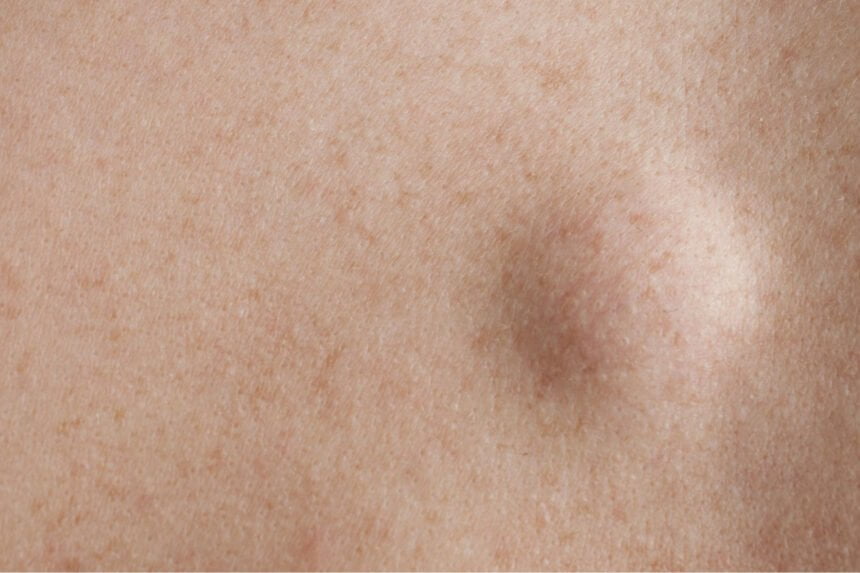Lipomas are benign tumors composed of fatty tissue that develop just beneath the skin. While they are not considered dangerous, they can cause discomfort and affect one’s physical appearance. While the exact cause of lipomas is not known, they are generally considered to be harmless and do not require treatment.
Understanding Lipomas
Lipomas are benign tumors that develop from fat cells or adipocytes. They are slow-growing and typically do not move under the skin. Lipomas are most commonly found in fatty tissues, such as the neck, shoulders, back, and thighs. They are usually painless and do not cause any harm.
Lipomas are composed of adipose tissue, which is a type of connective tissue that stores fat. They are not cancerous and do not increase the risk of developing cancer. However, it is important to have any new or changing lumps checked by a medical professional to rule out any other health concerns.
Lipomas can be diagnosed through physical examination and imaging tests, such as ultrasound or MRI. In most cases, they do not require treatment unless they are causing discomfort or affecting the appearance of the skin. Surgical removal is the most common treatment option for lipomas.
Common Locations of Lipomas
Lipomas can occur anywhere in the body where adipocytes are present, which means they can arise in both superficial and deep tissues. However, they are most commonly found in the subcutaneous tissue, which is the fatty layer just beneath the skin. Lipomas can also develop in the internal organs, such as the stomach and bowels, but this is less common.
The most frequent locations of lipomas are the trunk and upper extremities, including the back, arms, shoulders, and neck. In some cases, lipomas can also occur in the thighs and abdomen.
Lipomas on the skin are usually small and soft to the touch, with a smooth surface. They can be single or multiple, and they tend to grow slowly over time. Lipomas on the back are often found in the subcutaneous tissue and can be quite large, causing discomfort or pain.
Lipomas on the arms and shoulders are usually small and painless, but they can become larger and more noticeable over time. Lipomas on the neck can be particularly problematic, as they can cause compression of the surrounding structures, such as the nerves and blood vessels, leading to pain and discomfort.
Lipomas on the thighs and abdomen can be deep-seated and technically challenging to remove surgically. In these cases, imaging studies, such as MRI or CT scans, may be necessary to accurately locate the lipoma and determine the depth of the tumor.
Causes and Risk Factors
Lipomas are non-cancerous growths of fat cells that can occur anywhere in the body. The exact cause of lipomas is not known, but genetics is thought to play a role. Lipomas can be inherited or passed down from one generation to the next. They are more common in middle-aged and older adults, but can occur at any age.
Lipomas are more common in women than men, and they are more likely to occur in people who are overweight or obese. Hyperlipidemia, or high levels of fats in the blood, and diabetes mellitus have also been linked to an increased risk of developing lipomas.
While lipomas are generally harmless, they can sometimes be a sign of an underlying medical condition. In rare cases, lipomas can become cancerous. Liposarcoma is a type of cancer that can develop from fat cells and can sometimes be mistaken for a lipoma.
Trauma to an area of the body can also cause a lipoma to develop. However, this is rare and most lipomas occur spontaneously without any known cause.
Types of Lipomas
Lipomas are the most common subcutaneous tumors composed of adipose (fat) cells, often encapsulated by a thin layer of fibrous tissue. They can be classified into different types based on their location, size, and histopathological features.
Common Lipomas
Common lipomas are the most frequently encountered neoplasms by clinicians. They are usually small, painless, and slow-growing tumors that can occur in any part of the body. Common lipomas are often found in the body’s cephalic part, specifically in the head, neck, shoulders, and backs of patients. They are usually diagnosed in middle-aged adults and are more common in women than in men.
Giant Lipomas
Giant lipomas are a rare subtype of lipomas that can grow up to 10 cm or more in diameter. They are usually found in the trunk, thigh, and upper arm regions. Giant lipomas can cause discomfort, pain, and cosmetic concerns due to their large size.
Spindle Cell Lipomas
Spindle cell lipomas are a subtype of lipomas that are composed of spindle-shaped cells and collagen fibers. They are usually found in the subcutaneous tissues of the neck, back, and shoulders. Spindle cell lipomas are relatively rare and can be mistaken for other soft tissue tumors.
Pleomorphic Lipomas
Pleomorphic lipomas are a subtype of lipomas that have a mixture of adipose and fibrous tissue, as well as atypical spindle cells. They are usually found in the subcutaneous tissues of the extremities and trunk. Pleomorphic lipomas are relatively rare and can be misdiagnosed as liposarcomas.
Cutaneous Lipomas
Cutaneous lipomas are a subtype of lipomas that occur on the skin surface. They are usually small, soft, and painless tumors that can be easily diagnosed by physical examination. Cutaneous lipomas are more common in women than in men and can occur at any age.
Deep Tissue Lipomas
Deep tissue lipomas are a subtype of lipomas that occur in the deeper tissues of the body, such as the muscles, nerves, and tendons. They are usually larger and more difficult to diagnose than common lipomas. Deep tissue lipomas can cause pain, discomfort, and functional impairment.
Familial Multiple Lipomatosis
Familial multiple lipomatosis is a rare genetic disorder that causes the development of multiple lipomas in different parts of the body. It is usually inherited in an autosomal dominant pattern and can occur at any age. Familial multiple lipomatosis can cause cosmetic concerns and functional impairment.
Dercum Disease
Dercum disease is a rare disorder that causes the development of painful lipomas in different parts of the body. It is usually found in middle-aged women and can cause chronic pain, fatigue, and other symptoms. Dercum disease can be difficult to diagnose and treat, and its exact cause is still unknown.
Symptoms and Diagnosis
Lipomas are generally asymptomatic and are commonly discovered incidentally during a physical examination. However, if they grow large enough, they can cause discomfort and pain, particularly if they press on nearby nerves or organs. In rare cases, lipomas can become cancerous. Therefore, it is important to have any new lumps or growths examined by a doctor.
During a physical examination, a doctor will typically feel the lump and assess its size, location, and texture. They may also ask about any symptoms such as pain or tenderness. In some cases, imaging tests such as an MRI, CT scan, or ultrasound may be ordered to get a better look at the lump and its surrounding tissues.
If there is any suspicion that the lump may be cancerous, a tissue sample may be removed and examined under a microscope. This is known as a biopsy. Biopsies can help to confirm the diagnosis and determine the appropriate course of treatment.
It is important to note that not all lumps are lipomas. Other types of growths such as cysts, fibromas, and sarcomas can also occur. Therefore, it is crucial to have any new growths reviewed by a doctor and undergo a physical examination to determine the proper diagnosis and treatment plan.
Lipomas and Cancer Risk
Lipomas are benign soft tissue masses that are usually asymptomatic and slow-growing. They are the most common type of mesenchymal tumors, accounting for approximately 16% of all soft tissue tumors. Although lipomas are not cancerous, there has been some concern about their association with cancer.
Some studies have suggested that lipomas may be a risk factor for certain types of cancer, such as liposarcoma. Liposarcoma is a type of sarcoma that arises from fat cells and can be aggressive and difficult to treat. However, the overall risk of developing liposarcoma from a lipoma is extremely low, estimated to be less than 1%.
It is important to note that not all lipomas are the same. Some lipomas, called atypical lipomas, have a higher risk of developing into liposarcoma. Atypical lipomas are larger, deeper, and more irregularly shaped than typical lipomas. They may also have a higher number of blood vessels and a greater tendency to recur after removal.
In general, lipomas are not a cause for concern and do not need to be removed unless they are causing discomfort or affecting the patient’s quality of life. However, if a lipoma is suspected to be atypical after being examined by a dermatologist, further evaluation may be necessary to rule out the possibility of liposarcoma.
Biopsy and Lab Examination
To diagnose a lipoma, a doctor or dermatologist may perform a physical exam and suggest a biopsy or tissue sample removal for lab examination. A biopsy involves taking a small sample of tissue from the lipoma and examining it under a microscope to determine whether it is cancerous or not. Lab examination of the tissue sample can also help identify the type of cells present in the lipoma.
There are two types of biopsies that can be performed to diagnose a lipoma: incisional biopsy and core needle biopsy. An incisional biopsy involves removing a small piece of tissue from the lipoma with a scalpel, while a core needle biopsy involves using a needle to remove a small sample of tissue from the lipoma. Core needle biopsy is recommended for all lipomatous masses larger than 3-5 cm to identify those masses that are malignant prior to excision.
Lab examination of the tissue sample can help distinguish lipoma from other soft tissue tumors that may resemble lipoma. It can also help identify the grade of the tumor, which can help determine the best course of treatment. A lipoma is usually benign, but in rare cases, it may be cancerous. If the lipoma is cancerous, it is called a liposarcoma.
Treatment and Removal Methods
Lipomas are usually benign and do not require treatment unless they are causing discomfort or are unsightly. If the lipoma is small and does not cause any symptoms, doctors may recommend leaving it alone and monitoring it for changes. However, if the lipoma is large, causing pain, or interfering with daily activities, treatment may be necessary.
Surgical Removal
The most common treatment for lipomas is surgical removal. This involves making an incision in the skin and cutting out the lipoma. Recurrences after removal are uncommon, but possible side effects are scarring and bruising. A technique known as minimal excision extraction may result in less scarring.
Liposuction
Liposuction is another option for removing lipomas. This procedure involves inserting a thin tube called a cannula into the skin and using suction to remove the fatty tissue. Liposuction is typically used for smaller lipomas and may result in less scarring than surgical removal.
Medications
In some cases, medications may be used to treat lipomas. Steroid injections can be used to shrink the size of the lipoma, but this treatment is not always effective. Another medication called adipotide is being studied as a potential treatment for lipomas, but it is not yet approved for use.
Possible Complications and Recurrence
In general, lipomas are benign tumors that do not pose any significant risks to a person’s health. However, in rare cases, lipomas can cause complications, such as nerve compression, which can lead to pain or numbness in the affected area.
Lipomas can also cause cosmetic concerns, especially if they are located in visible areas of the body. In such cases, a person may opt for surgical removal of the lipoma for aesthetic reasons. However, it is important to note that the removal of a lipoma can result in a scar, which may be noticeable, depending on the size and location of the lipoma.
Recurrence of a lipoma after surgical removal is uncommon, but it can still occur. The risk of recurrence is higher if the lipoma was not completely removed during the initial surgery. In such cases, a second surgery may be needed to remove the remaining tumor.
While the risks associated with lipoma removal are generally low, as with any surgical procedure, there are potential risks, such as bleeding, infection, and adverse reactions to anesthesia. However, these risks are rare and can be minimized by choosing an experienced surgeon and following proper post-operative care.
Overall, while lipomas are generally harmless, it is still important to have them examined by a medical professional to rule out any potential risks or underlying health conditions.








